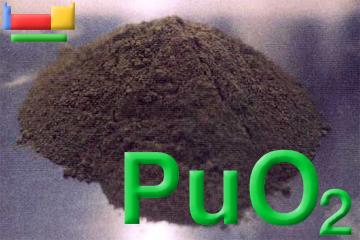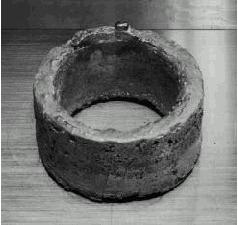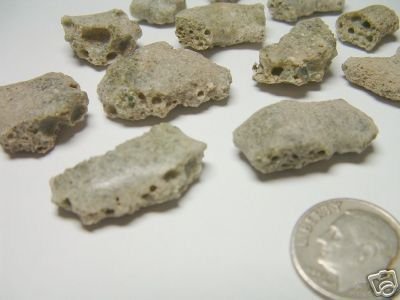


Various images of plutonium metal.
94 - Plutonium



Various
images of plutonium metal.

A sample of 0.89 g of highly pure plutonium (99.99%). This sample, a standard for analysis,
was
manufactured at Los Alamos, in a oxygen-free environment, and sealed under
vacuum in a glass ampoule.

Pu(IV)
colors change with different ligands.

Colors of the different oxidation states of plutonium, in 1 M HClO4. (Pu(V)
is in NaClO4 at pH=7, Pu(VII) is in 2.5 M NaOH.)

A hemisphere of purified, but gallium-stabilized, delta-phase plutonium metal.

Buttons of refined plutonium metal.

Plutonium oxide.
Chemical Properties
Plutonium is a highly reactive, silvery metal, which reacts immediately with oxygen and water vapor in air, quickly tarnishing to almost all the colors of the rainbow. Plutonium metal has many highly unusual properties. Depending on its crystal structure, it can be either brittle or ductile. Its radioactivity causes self-irradiation, which can change the properties drastically with time. It expands upon solidifying, like water, and unlike almost all other materials. It has six different crystal structures, and can change density by as much as 25%. The melting point, 640 C, is very low, but the boiling point, 3327 C, is fairly high. When liquid, plutonium has a very high surface tension, and the largest viscosity of all the elements. It is an unusually poor electrical and thermal conductor. At low temperatures, the crystal never attains a long-range order, like other metals do.
An explanation for these bizarre properties comes from the behavior of the 5f electrons. First, consider the more familiar lanthanide metals. As you advance along the periodic table, these elements are filling in the 4f electron shell. The 4f electrons stay well inside the outermost electrons of these atoms. As a result, they do not have much effect on the chemical properties of the elements, and the lanthanides all have very similar chemical properties, and typically displaying a +3 oxidation state.
In the heavier atoms of the actinides, this picture is modified. In these heavy elements, the outer electrons travel at very high velocities, approaching the speed of light, and the effects of relativity become important. As a result of the relativistic effects, the outermost 7s electrons are pulled inwards. In the case of the heavier actinides, beyond plutonium, the result is still that the 5f electrons are inside these outermost 7s electrons, and these elements all have similar chemical properties, analogous to the lanthanides. In the case of the lighter actinides, for example thorium and uranium, the 5f electrons stick out far enough beyond the 7s shell to participate in chemistry. These lighter actinides behave somewhat like transition metals, with the 5f electrons behaving as d electrons do in typical transition elements. For example, Th and U have different typical oxidation states, +4 and +6.
Plutonium is on the boundary between these two regions. The 5f electrons stick out far enough to have an effect upon its chemistry, but not far enough to behave normally. This in-between situation contributes to the strange properties of this element, and therefore plutonium shows therefore a high sensitivity to pressure, temperature and alloying constituents.
Manufacture and Fabrication
All plutonium originates in nuclear reactors and is produced by the capture
of extra neutrons by uranium-238 to form U-239, which then undergoes a series of
decays to form Pu-239:
U-238 + n -> U-239 -> Np-239 -> Pu-239
Some of this plutonium gets consumed by fission before it is removed from the
reactor, and some of it gets transmuted to heavier isotopes of plutonium by
capturing more neutrons:
Pu-239 + n -> Pu-240
The isotopic composition of plutonium is affected by how long it stays in the reactor. Short exposures produce plutonium with very little Pu-240 and with very little plutonium being consumed by fission. Long exposures produce high Pu-240 concentrations, and a substantial portion of the plutonium produced is consumed by fission.
The isotopic composition matters with regard to manufacturing weapons for two reasons. First (and least important) is that Pu-240 is less fissile then Pu-239, so somewhat more plutonium is needed to make up the required amount for the weapon. Second (and more important) is that Pu-240 decays through spontaneous fission, producing a substantial flux of neutrons.
In the earliest years of weapon design the emission of neutrons was a problem in making a reliable efficient weapon because of the problem of predetonation. A high neutron flux makes it difficult or impossible to compress a bomb core containing several kilograms of plutonium to supercriticality before the bomb disassembled with a greatly reduced yield. The advent of composite cores containing highly enriched U-235 and plutonium (in the late 1940s) greatly reduced this difficulty though since the option of using a relatively small amount of plutonium in a mostly uranium core became available. The later development of fusion boosted weapons (in the mid 1950s) eliminated it entirely since the fusion boosting effect ensures efficient weapons, even with low initial fission yields.
Plutonium can be obtained from special purpose plutonium production reactors, or as a by-product of commercial power or research reactors. The plutonium produced by special purpose production reactors has a relatively low Pu-240 content (<7%) and is called "weapons grade", while commercial reactors may produce plutonium with Pu-240 with concentrations of >20% and is called "reactor grade".
Essentially all of the plutonium currently in weapons throughout the world was produced in special purpose plutonium production reactors. Initially each of the five declared nuclear powers began producing plutonium for weapons on a large scale many years before they developed significant numbers of commercial power reactors. Special purpose reactors were required for weapons production because there was no other sources of plutonium available.
These special purpose reactors produce "weapon grade" plutonium, as opposed to grades with higher Pu-240 concentrations, for two reasons. First, economics. The only reason the reactor exists is to produce plutonium. Burning plutonium up in fission, or transmuting it to less fissile Pu-240 reduces output and increases cost (up to a point, this must be balanced against the cost of processing fuel with low plutonium concentrations). Second, handling problems. Although neutron emissions do not create serious problems in weapon design, it can produce problems with weapons manufacture and handling. Neutron emissions create occupational exposures to plutonium for those assembling weapons, or handling weapons already assembled. In fact weapons that are kept in close proximity to people (like the W80-0) may even require special "supergrade" low neutron emission plutonium for this reason.
The peculiar material properties of plutonium require some special treatment to make it suitable for weapons. Pure plutonium, after it cools to room temperature, will shrink by around 25%, drastically changing shape, and becomes brittle. However, when alloyed with gallium, about 1% by weight, plutonium behaves as a more normal metal. This composition is used in weapons manufacture.

Plutonium processing glove boxes.
The actual fabrication and processing of plutonium is done manually in glove boxes like these at Los Alamos, which means there is negligible shielding between the operator and the neutron-emitting plutonium. If higher Pu-240 plutonium were used in weapons, then either remote control processing cells would have to be used, or the number of hours that each worker could spend at these tasks would have to be sharply reduced. Either of these would drive up the cost of weapon processing considerably. It is for this reason, as well as historical and policy reasons, that explain why reactor grade plutonium is not used in U.S. weapon. It is not due to any inherent inability to do so (contrary to some statements made by the nuclear power industry).

High purity plutonium ring.
This ring of electrorefined plutonium metal has a purity of more than 99.96 per cent. It is typical of the rings that were prepared at Los Alamos and shipped to Rocky Flats for weapon fabrication before the latter facility was shut down, and U.S. weapon manufacture halted. The ring weighs 5.3 kilograms, enough for one bomb core, and is approximately 11 centimeters in diameter. The ring shape is important for criticality safety. There is enough plutonium in this ring to make a modern strategic nuclear weapon.

Plutonium-gallium alloy ingot reclaimed from weapon pit.
Collectiblity

Trinitite samples.
The only practical way to collect a sample of plutonium is to get some of the mineral known as 'trinitite'. This material was formed in the first nuclear bomb test, code named Trinity, conducted near Alamogordo New Mexico in 1945. The intense heat of the explosion melted the desert sand into glass, which then absorbed some of the debris from the bomb, including both fission products and unreacted plutonium, before solidifying. Samples, which are only slightly radioactive, are easily available on eBay. Obviously, large samples of pure plutonium do exist, but you would get in a whole lot of trouble if you tried to obtain one!
References
http://www.kernchemie.de/Actinides/Plutonium/plutonium.html - Plutonium - Element with many facets. An excellent site (in German) from which I borrowed heavily.
http://nuclearweaponarchive.org/Library/Plutonium/ - Plutonium manufacture and fabrication. An excellent source of information and pictures. I plagiarized blatantly from this source.
Colored plutonium solution photos by of David E. Hobart, Berkeley, California, 1991. Obtained from the Glen Seaborg archives.